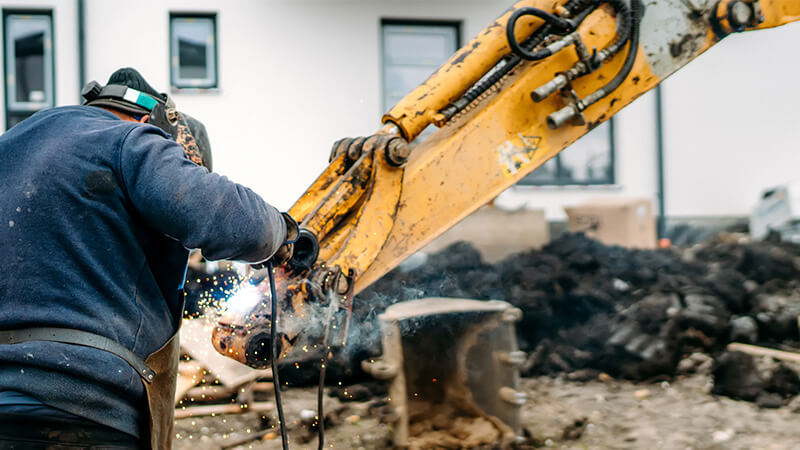There are a good variety of hardfacing methods available, each one with its own advantages and disadvantages. This list can be so long and specific that can become overwhelming for the responsible person in the workshop.
Since we know how complex this topic can be, and many of our clients are looking for answers, in this article, we are going to point out only 5 of the most common hardfacing methods. For each one of them, we are going to highlight the pros and cons. This surely is going to shed some light on the discussion. But before that, let’s review the basics.
What is hardfacing
Hardfacing is a process of applying a wear-resistant layer of metal to a surface that is subject to wear and abrasion. The goal of hardfacing is to extend the service life of a component by improving its wear resistance and durability.
Hardfacing is typically done by welding or thermal spraying a layer of hard, wear-resistant material onto the surface of the component. The hardfacing material can be a variety of different alloys, such as high-carbon steel, stainless steel, cobalt alloys, or nickel-based alloys.
The specific hardfacing material used will depend on the type of wear and abrasion that the component is expected to encounter, as well as the operating conditions of the equipment. Some hardfacing materials are better suited for high-impact wear, while others are better for sliding wear. For example, cobalt alloys contain some types of carbides and are ideal for severe abrasion at high temperatures, but not necessarily to withstand hard impacts. The tensile strength of the filler metal chosen can give you an indication of what the material is better suited for.
Hardfacing can be applied to a wide range of components, including mining equipment, agricultural machinery, valves and pumps, drilling tools, and machine parts. Some examples of components that are commonly hardfaced include buckets, teeth, and blades for excavators and bulldozers, wear plates for chutes and hoppers, and rolls and guides for steel mills.
In a few words, hardfacing is an effective way to extend the service life of components that are subject to wear and abrasion, helping to reduce maintenance costs and improve the performance and productivity of the equipment.
When hardfacing is needed?
Hardfacing is typically needed when a component is subject to wear and abrasion which reduces its service life and causes increased maintenance costs or equipment downtime. The need for hardfacing may arise in a variety of industrial applications, such as mining, construction, agriculture, and manufacturing.
Some specific situations where hardfacing may be needed include the following:
High-wear environments: Components that are subject to high-wear environments, such as mining equipment, crushing and grinding machinery, and earthmoving equipment, may require hardfacing to improve their wear resistance.
Abrasive materials: Parts that come into contact with abrasive materials, such as sand, gravel, or concrete, may require hardfacing to protect against abrasion.
High-temperature environments: Pieces that operate in high-temperature environments, such as furnaces or boilers, may require hardfacing to protect against heat-related wear and erosion.
Corrosive environments: Components that operate in corrosive environments, such as chemical processing equipment or marine applications, may require hardfacing to protect against corrosion-related wear.
Heavy impact or shock loads: Parts that are subject to heavy impact or shock loads, such as hammer mills, may require hardfacing to improve their impact resistance.
Most likely, any or a few of these 5 conditions might describe the use your parts or components face, which makes hardfacing a need for your equipment. So, let’s now go into detail with the selection of 5 hardfacing methods used most commonly.
5 common hardfacing methods
Even though there are several welding processes that can be used for hardfacing, we are going to consider now only the 5 most common methods, each with its own advantages and disadvantages. They are the following:
- Shielded Metal Arc Welding (SMAW)
- Gas Tungsten Arc Welding (GTAW)
- Gas Metal Arc Welding (GMAW)
- Flux-Cored Arc Welding (FCAW)
- Plasma Transferred Arc Welding (PTAW)
The choice of hardfacing method will depend on several factors, including the type of component being hardfaced, the specific hardfacing material being used, and the desired properties of the hardfaced surface.
Hardfacing method 1: Shielded Metal Arc Welding (SMAW or STICK)
Shielded Metal Arc Welding (SMAW), also known as manual metal arc welding (MMA) or STICK welding, is a welding process that uses a consumable electrode coated in flux to join two pieces of metal together. STICK is a versatile welding process that can be used to weld a variety of metals, including steel, stainless steel, cast iron, and nickel alloys.
In STICK, an electric arc is created between the tip of the electrode and the workpiece, melting both the electrode and the base metal. The flux coating on the electrode melts and creates a protective gas shield around the weld pool, preventing oxidation and contamination of the weld.
The flux coating on the electrode also provides several other functions, including
- Deoxidizing the weld metal and removing impurities
- Adding alloying elements to the weld metal to improve its properties
- Providing a slag layer that protects the weld as it cools and solidifies
STICK is a versatile welding process that can be used in a variety of positions, including flat, horizontal, vertical, and overhead. Besides hardfacing, it is commonly used in construction, pipeline welding, and repair work, as well as in manufacturing and fabrication.
Some advantages of STICK include its portability, and low equipment cost. However, it is a relatively slow welding process and requires a high degree of skill and expertise to produce high-quality welds.
Advantages of Shielded Metal Arc Welding (SMAW or STICK) for hardfacing
Versatility: STICK can be used for hardfacing a wide range of base materials, including carbon steel, low alloy steel, stainless steel, and cast iron, making it a versatile process for various hardfacing applications.
Portability: The equipment is relatively portable, as it does not require a separate shielding gas supply or complex wire feeding systems. This makes STICK suitable for field applications or remote locations where other welding processes may be impractical.
Accessibility: It is a widely available welding process, and the equipment and consumables, such as electrodes, are generally readily available, making them accessible for many operations.
Cost-effective: It can be a cost-effective option for hardfacing, as the equipment and consumables are typically less expensive compared to some other welding processes. STICK electrodes for hardfacing are available in a variety of alloy compositions, allowing for cost-effective customization based on specific requirements.
Simple operation: It is relatively simple to set up and operate, making it suitable for both experienced and novice welders. It does not require complex wire feeding systems or extensive parameter adjustments, which can make it easier to use for hardfacing applications.
Ability to weld in different positions: It can be used in various welding positions, including flat, horizontal, vertical, and overhead, giving it versatility for hardfacing applications on different types of workpieces and in different orientations.
Strong and durable welds: STICK can produce hardfacing welds with good mechanical properties, such as high hardness, good wear resistance, and good bonding with the base material, which makes it suitable for hardfacing applications where increased wear resistance and durability are desired.
Disadvantages of Shielded Metal Arc Welding (SMAW or STICK) for hardfacing
Lower deposition rates: Compared to some other welding processes, STICK typically has lower deposition rates, which means it may take longer to apply a given amount of hardfacing material. This can impact productivity, especially for large-scale hardfacing applications where high deposition rates are desired.
Slag formation: STICK generates slag during the welding process, which must be chipped or brushed away after each pass. Slag can interfere with the quality of the hardfacing deposit and may require additional post-weld cleaning, which can add to the overall labor and time involved in the hardfacing process.
Limited positional capability: While STICK can be used in various welding positions, it may have limitations in certain positions, such as overhead or vertical-up welding, which can be more challenging and time-consuming compared to flat or horizontal welding. This can affect the efficiency and quality of the hardfacing process, depending on the specific application.
Electrode handling and maintenance: The electrodes are consumable and need to be replaced periodically during welding. Electrode handling, storage, and maintenance are critical to ensure proper performance and prevent issues such as moisture absorption, electrode degradation, or electrode sticking to the workpiece.
Operator skill requirements: It requires good manual dexterity, eye-hand coordination, and experience to achieve high-quality hardfacing welds. It may require more operator skill compared to some other welding processes, and the quality of the hardfacing deposit can be greatly influenced by the skill level of the welder.
Limited automation potential: It is a manual welding process that requires the welder to control the electrode positioning and welding parameters, which may limit the potential for automation and mechanization in certain hardfacing applications. Automated or mechanized hardfacing processes may be more suitable for high-volume or repetitive hardfacing applications.
Hardfacing method 2: Flux Cored Arc Welding (FCAW)
Flux Cored Arc Welding (FCAW) is a welding process that uses a continuous tubular electrode filled with flux to join two pieces of metal together. FCAW is a versatile welding process that can be used to weld a variety of metals, including steel, stainless steel, aluminum, and nickel alloys.
In FCAW, a wire feeder pushes a continuous tubular electrode through a welding torch. The electrode is filled with flux, which melts and forms a gas shield around the weld pool to protect it from contamination by the surrounding air. An electric arc is struck between the wire electrode and the workpiece, melting both the wire and the base metal. The molten metal from the wire and the base metal combine to form the weld.
FCAW is a fast welding process that can be used to produce high-quality welds in a variety of positions, including flat, horizontal, vertical, and overhead. It is commonly used in industries such as construction, fabrication, and shipbuilding.
Some advantages of FCAW include its versatility in welding a variety of metals, its high deposition rates, and its ability to weld in a variety of positions. However, FCAW produces a lot of smoke and fumes, which can be hazardous if proper ventilation is not provided. It also requires a high degree of skill and expertise to produce high-quality welds.
Advantages of Flux-Cored Arc Welding (FCAW) for hardfacing
High deposition rates: FCAW typically allows for higher deposition rates compared to some other welding processes, which can result in faster and more efficient hardfacing. This can be especially beneficial for large-scale hardfacing applications where high productivity is desired.
All-position capability: It is a versatile welding process that can be used in all welding positions, including flat, horizontal, vertical, and overhead. This makes it suitable for a wide range of hardfacing applications, including those with challenging geometries or access limitations.
Self-shielding option: It can be performed with self-shielding electrodes, which eliminates the need for an external shielding gas. This can be advantageous in outdoor or remote locations where gas cylinders may not be practical or readily available. Self-shielded FCAW electrodes are also less sensitive to wind and draft conditions compared to gas-shielded processes.
Deep penetration: It can provide deep penetration into the base metal, which can result in a strong and durable hardfacing deposit. This can be beneficial for applications where high wear resistance or impact resistance is required.
Easy to learn and use: It is relatively easy to learn and use, making it accessible to a wide range of welders, including those with limited welding experience. FCAW typically requires less operator skill compared to some other welding processes, such as TIG, which can result in quicker training and qualification of welders for hardfacing applications.
Versatility in hardfacing materials: It allows for the use of a wide range of hardfacing materials in the form of flux-cored wires, including a variety of metal alloys, carbides, and other hardfacing materials. This offers flexibility in selecting the appropriate hardfacing material for specific wear conditions or application requirements.
Potential for automation: FCAW can be easily automated and mechanized, making it suitable for high-volume or repetitive hardfacing applications. Automated FCAW systems can offer improved consistency, precision, and productivity in hardfacing operations.
Disadvantages of Flux-Cored Arc Welding (FCAW) for hardfacing
Potential for slag inclusion: FCAW produces slag as part of the welding process, which can potentially become trapped in the hardfacing deposit. This can result in reduced quality and performance of the hardfacing layer, leading to increased wear or decreased mechanical properties.
Higher fume and spatter generation: It can produce higher levels of welding fumes and spatter compared to some other welding processes. The fumes and spatter can pose health hazards to the welder and other people in the vicinity, requiring proper ventilation, respiratory protection, and safety measures to minimize exposure.
Sensitivity to environmental conditions: It can be sensitive to environmental conditions such as wind, drafts, and humidity, which can affect the stability of the arc and the quality of the weld. Wind or drafts can blow away the shielding gas and affect the weld quality, while high humidity can cause moisture to be absorbed by the flux-cored wire, leading to porosity in the weld.
Equipment complexity: It requires specialized equipment, including a welding machine capable of handling flux-cored wires and the necessary shielding gas supply. The equipment can be more complex compared to some other welding processes, which may require additional training and setup time.
Limited precision: It may not provide the same level of precision and control as some other welding processes, such as TIG, due to factors such as the size of the flux-cored wire and the presence of slag. This may limit its suitability for certain high-precision hardfacing applications.
Material limitations: It is typically used for hardfacing with ferrous materials, and may not be as suitable for hardfacing non-ferrous materials or exotic alloys. The selection of suitable flux-cored wires for specific materials or applications may be more limited compared to other welding processes.
Higher costs: Flux-cored wires used in FCAW can be more expensive compared to solid wires used in other welding processes, which can increase the overall cost of hardfacing operations. Additionally, the need for external shielding gas, if used, can add to the cost and complexity of the process.
Hardfacing method 3: Gas Metal Arc Welding (GMAW or MIG)
Gas Metal Arc Welding (GMAW), also known as Metal Inert Gas (MIG) welding, is a welding process that uses a continuous consumable metal wire electrode, an electric arc, and a shielding gas to join two pieces of metal together. MIG is a versatile welding process that can be used to weld a variety of metals, including steel, stainless steel, aluminum, and copper alloys.
In MIG, a wire feeder pushes a continuous wire electrode through a welding torch. The welding torch also feeds a shielding gas, such as argon or a mixture of argon and carbon dioxide, which protects the weld from contamination by the surrounding air. An electric arc is struck between the wire electrode and the workpiece, melting both the wire and the base metal. The molten metal from the wire and the base metal combine to form the weld.
MIG is a fast welding process that can be used to produce high-quality welds in a variety of positions, including flat, horizontal, vertical, and overhead. It is commonly used in industries such as automotive, fabrication, and construction.
Advantages of Gas Metal Arc Welding (GMAW or MIG) for hardfacing
High deposition rates: MIG allows for high deposition rates, which means that a significant amount of hardfacing material can be deposited in a relatively short amount of time. This can result in increased productivity and efficiency in hardfacing operations, reducing labor costs and minimizing downtime.
Less slag and spatter: It produces less slag and spatter compared to some other welding processes, such as STICK or FCAW. This can result in cleaner and smoother hardfacing deposits with less post-weld cleanup required.
Better control and precision: It provides good control over the welding process, allowing for precise deposition of hardfacing material. The operator can control the welding parameters, such as voltage, wire feed speed, and shielding gas flow, to achieve the desired hardfacing results, including bead geometry, dilution, and penetration.
Versatility: It is a versatile welding process that can be used for a wide range of hardfacing applications, including on ferrous and non-ferrous materials, and with a variety of hardfacing materials, such as solid wires, metal-cored wires, and flux-cored wires. This flexibility allows for customization of the hardfacing process to suit the specific requirements of the application.
Good weld quality: It can produce high-quality hardfacing deposits with good mechanical properties and minimal defects, such as porosity if the process is properly controlled and parameters are optimized. This can result in hardfacing overlays that exhibit good wear resistance, toughness, and durability.
Higher operator comfort: It is generally considered to be a more comfortable welding process for operators compared to some other processes, such as STICK or FCAW, as it produces less smoke, fumes, and spatter. This can lead to a more comfortable working environment, reduced operator fatigue, and improved safety.
Cost-effective: MIG can be a cost-effective hardfacing method, as it allows for high deposition rates, reduces post-weld cleanup, and requires less overall labor compared to some other welding processes. Additionally, solid wires used in MIG are typically less expensive than flux-cored wires used in FCAW, which can result in cost savings in consumables.
It’s important to note that the advantages of MIG for hardfacing may vary depending on the specific application, material, and desired hardfacing results.
Disadvantages of Gas Metal Arc Welding (GMAW or MIG) for hardfacing
Limited suitability for certain materials and environments: MIG may not be suitable for all materials and environments in hardfacing applications. For example, it may not be ideal for hardfacing materials that are prone to cracking or require high heat input due to its relatively low heat input compared to other welding processes like STICK or FCAW. Additionally, it may not be suitable for certain environments with high levels of moisture or contaminants, as it requires a clean and dry welding environment to prevent weld defects.
Sensitivity to joint fit-up and surface preparation: It can be sensitive to joint fit-up and surface preparation, as it requires proper joint fit-up and surface cleanliness for successful welding. Insufficient joint fit-up or inadequate surface preparation can result in poor fusion, incomplete penetration, or increased chances of weld defects, which can compromise the quality and integrity of the hardfacing overlay.
Equipment complexity and cost: Typically requires more complex and expensive equipment compared to some other welding processes, such as STICK. The equipment includes a power source, wire feeder, shielding gas supply, and welding torch, which may require additional setup, maintenance, and calibration. This can result in higher initial setup costs and ongoing maintenance costs, which may not be suitable for all budgets or applications.
Deposition rate limitations for thick overlays: While MIG can provide high deposition rates, it may have limitations when it comes to depositing thick overlays. It may require multiple passes to build up a thick overlay, which can result in additional welding time, increased heat input, and potential distortion or warping of the base material.
Dependence on shielding gas: It relies on a shielding gas to protect the weld pool from atmospheric contamination, and the selection and management of shielding gas can be critical for successful hardfacing. The cost, availability, and proper handling of shielding gas can be factors to consider in the overall cost and feasibility of hardfacing operations.
Operator skill and training requirements: It requires proper training, skill, and experience to achieve optimal hardfacing results. The operator needs to have good control over welding parameters, such as voltage, wire feed speed, and shielding gas flow, and be skilled in techniques like maintaining proper torch angle, travel speed, and bead placement to achieve the desired hardfacing results. Improper technique or lack of operator skill can result in poor-quality hardfacing deposits with reduced wear resistance or increased chances of weld defects.
Hardfacing method 4: Metal-Cored Arc Wire (MCAW)
Metal Cored Arc Wire (MCAW) is a process that falls under the category of arc welding. It is similar to Flux Cored Arc Welding (FCAW) in that it uses a continuously fed consumable electrode to melt and join two pieces of metal together. However, unlike FCAW where the core of the electrode is filled with flux, in MCAW, the core is filled with a solid metal powder.
The MCAW process uses a welding torch that is connected to a welding power source. The welding torch feeds a continuously fed metal-cored electrode wire, which serves as both the filler metal and the electrode. When the electrode wire is energized by the welding power source, an electric arc is created between the electrode and the workpiece, causing the metal to melt and form a weld pool. The solid metal powder in the core of the electrode wire melts and provides additional alloying elements to the weld pool, helping to improve the mechanical properties of the weld.
MCAW is known for its high deposition rates, which means it can deposit a large amount of weld metal in a short amount of time, making it a productive welding process. It is commonly used in heavy fabrication and manufacturing industries where high welding speeds and high deposition rates are desired. MCAW is also used in applications where high-quality welds with excellent mechanical properties are required, such as in structural steel construction, pipeline welding, and heavy equipment fabrication.
Advantages of Metal Cored Arc Wire (MCAW) for hardfacing
High deposition rates: MCAW can achieve higher deposition rates compared to other welding processes, making it an efficient and productive method for hardfacing.
Good weld quality: It produces a smooth and consistent weld bead, which helps to maintain good weld quality and integrity.
Easy to use: It is easy to set up and use and does not require as much skill and experience as some other welding processes.
Minimal spatter: It produces minimal spatter, which reduces the need for post-weld cleanup and minimizes material waste.
Versatility: It can be used for a wide range of base metals and hardfacing alloys, making it a versatile welding process.
Increased efficiency: MCAW is a semi-automatic process, which means that it can be easily integrated into automated welding systems to increase efficiency and productivity.
Disadvantages of Metal Cored Arc Wire (MCAW) for hardfacing
Equipment cost: The equipment needed for MCAW can be more expensive than for some other welding processes.
Limited mobility: Typically requires a stationary welding position, which can limit its mobility compared to some other welding processes.
Limited access: It may not be suitable for hardfacing applications in tight or hard-to-reach areas, where access is limited.
Environmental concerns: It can produce emissions and waste products, which may raise environmental concerns if not managed properly.
Limited application thickness: It may not be suitable for hardfacing applications where the required hardfacing thickness exceeds the maximum thickness that can be achieved with the equipment and process.
Limited operator control: MCAW can be less controllable than some other welding processes, which can lead to less precise welds and potentially higher levels of distortion or cracking.
Hardfacing method 5: Submerged Arc Welding (SAW)
Submerged Arc Welding (SAW) is a welding process that utilizes a continuously fed consumable electrode and a layer of flux to generate an electric arc that melts the base metal and the electrode, forming a weld. The arc is “submerged” under the layer of flux, which provides a protective cover to the molten weld pool, preventing it from being exposed to the surrounding atmosphere.
In SAW, the welding electrode, typically a solid wire or a strip, is continuously fed from a wire reel into the welding joint, while the flux is deposited on top of the joint. The flux serves multiple purposes in the process, including generating a protective gas shield, providing slag coverage to protect the weld pool from impurities, and improving the weld quality by controlling the penetration and shape of the weld bead.
SAW is known for its high deposition rates and deep penetration capability, making it suitable for welding thick materials in applications such as heavy fabrication, shipbuilding, and structural steel construction. It is a highly efficient welding process that can achieve high welding speeds and produce high-quality welds with good mechanical properties.
Advantages of Submerged Arc Welding (SAW) for hardfacing
High deposition rates: SAW is capable of depositing large amounts of hardfacing material quickly, making it a fast and efficient process.
High-quality welds: It produces high-quality welds with excellent mechanical properties, including high strength and low porosity.
Low distortion: It generates low heat input, which minimizes distortion and prevents warping of the workpiece.
Suitable for thick materials: It is particularly well-suited for welding thick materials, making it an ideal choice for heavy equipment and machinery.
Minimal operator intervention: It is a highly automated process that requires minimal operator intervention, making it easy to use and reducing the risk of human error.
Good for long, continuous welds: SAW is ideal for long, continuous welds where consistent quality and deposition rates are required.
Disadvantages of Submerged Arc Welding (SAW) for hardfacing
Limited versatility: SAW is not well-suited for welding thin materials or in tight spaces due to the large size of the equipment and the need for a flux layer.
High initial setup cost: It requires specialized equipment and a dedicated welding setup, which can be costly to purchase and install.
Limited mobility: The equipment used for SAW is generally not portable, which can be a limitation for some welding applications.
Environmental concerns: The use of a flux layer in SAW can generate significant smoke and fumes, which can be a health hazard to the operator and require adequate ventilation and protective equipment.
Limited welding positions: It is best suited for flat or horizontal welding positions, which can be a limitation for certain welding applications that require vertical or overhead welding.
Additionally, operators must follow proper procedures for handling and disposing of flux, and use appropriate personal protective equipment (PPE) to ensure safe welding operations.
Equipment needed for hardfacing
The equipment needed for hardfacing depends on the specific welding process being used. However, some of the basic equipment required for hardfacing include the following items.
Electrode or wire: The electrode or wire is the consumable material that is melted and deposited onto the workpiece to create the weld.
Hardfacing filler material: Depending on the specific application, a variety of hardfacing filler materials may be used, including tungsten carbide, chromium carbide, and cobalt-based alloys. These materials are specially formulated to provide superior wear resistance and durability in harsh environments.
Flux or shielding gas: Depending on the welding process being used, a flux or shielding gas may be required to protect the molten metal from the surrounding air, preventing it from oxidizing.
Protective gear: Operators must wear protective gear, including gloves, safety glasses, and helmets, to protect themselves from the intense heat and bright light produced during the welding process.
Surface preparation equipment: Proper surface preparation is essential for achieving a high-quality hardfacing weld. Equipment such as grinders, wire brushes, beveling machines, and sandblasters may be required to remove any rust, paint, or other contaminants from the workpiece before welding.
Welding machine: It is required to provide the electrical power needed to create the arc or plasma necessary for the welding process. Let’s take a glance over 5 welding machines:
Miller XMT 350 FieldPro
The Miller XMT 350 Fieldpro with Suitcase ArcReach 12 Wire Feeder represents a step forward a more efficient welding operation. Backed by ArcReach® technology, it increases productivity in the field.
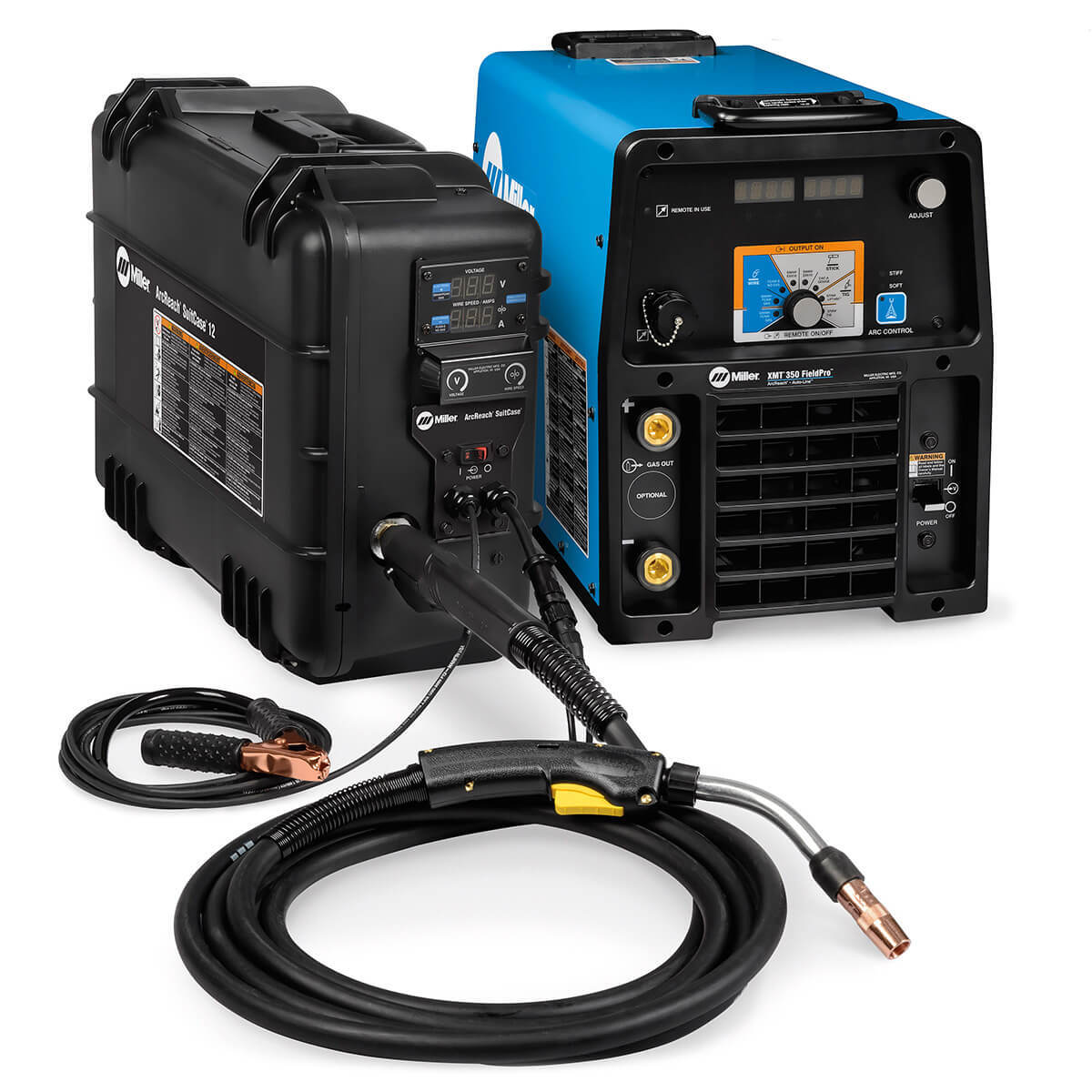
Miller XMT 450 CC/CV
The Miller XMT 450 CC/CV is the most popular model for its flexibility and simplicity. Portability and excellent arc performance make the XMT family the most popular in the industry for hardfacing.
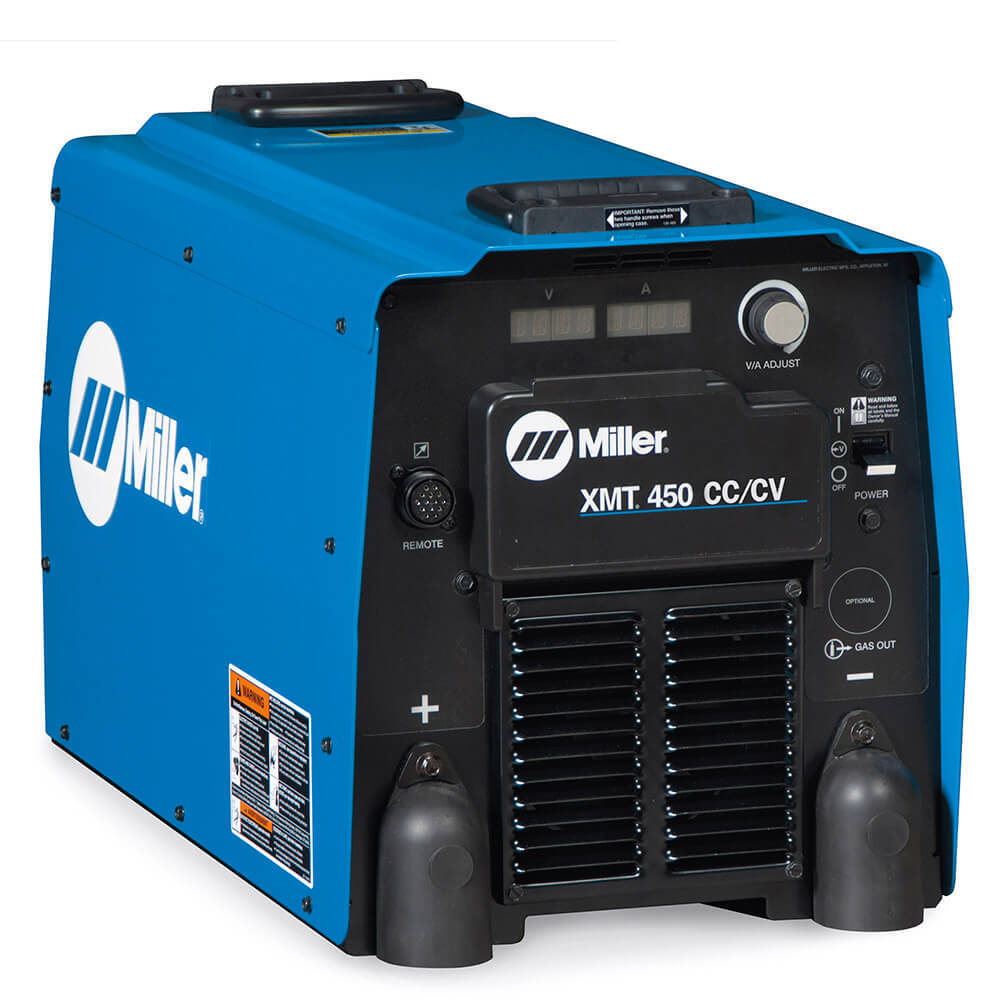
Miller Dimension 650
The Miller Dimension 650 has been developed for harsh environmental conditions and output requirements that range from power-intensive to precise.
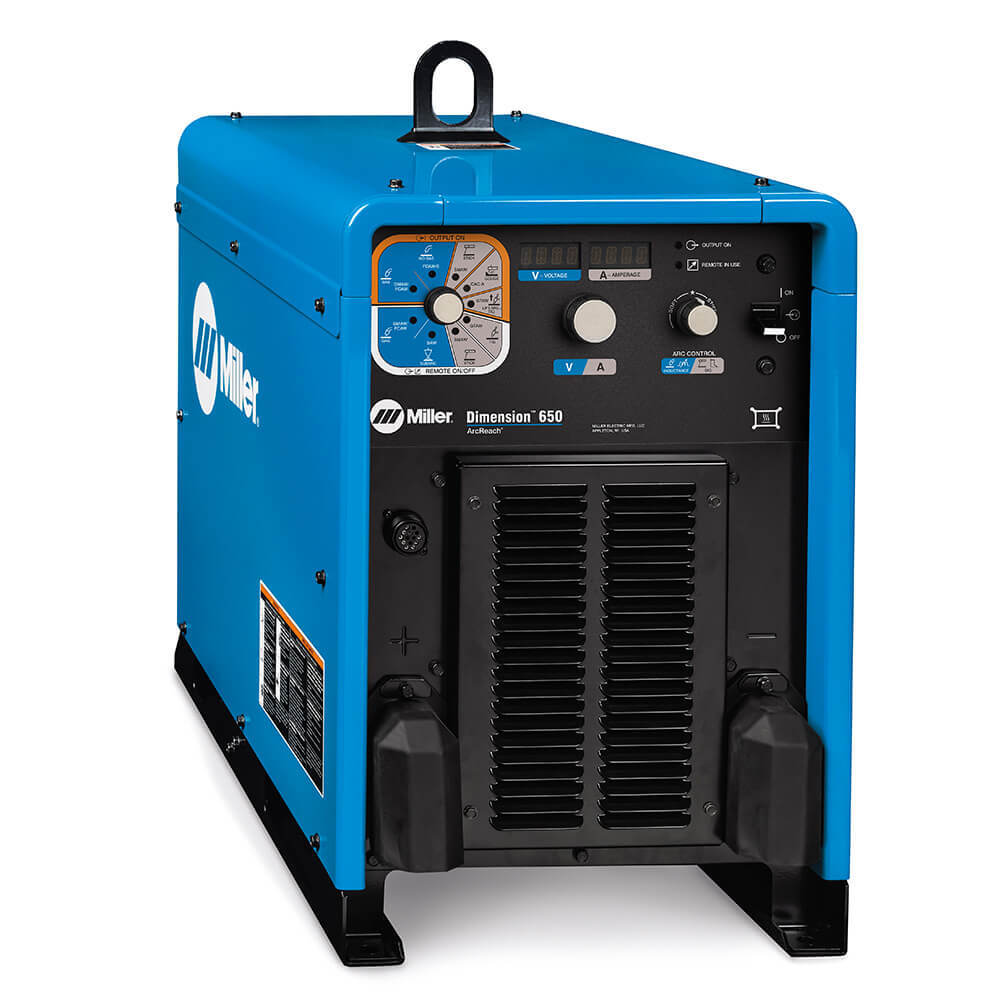
Miller Big Blue 400 Pro
The Miller Big Blue 400 Pro has been designed with the professional welder in mind. Is the best for ease of use, reliability, and fuel economy.
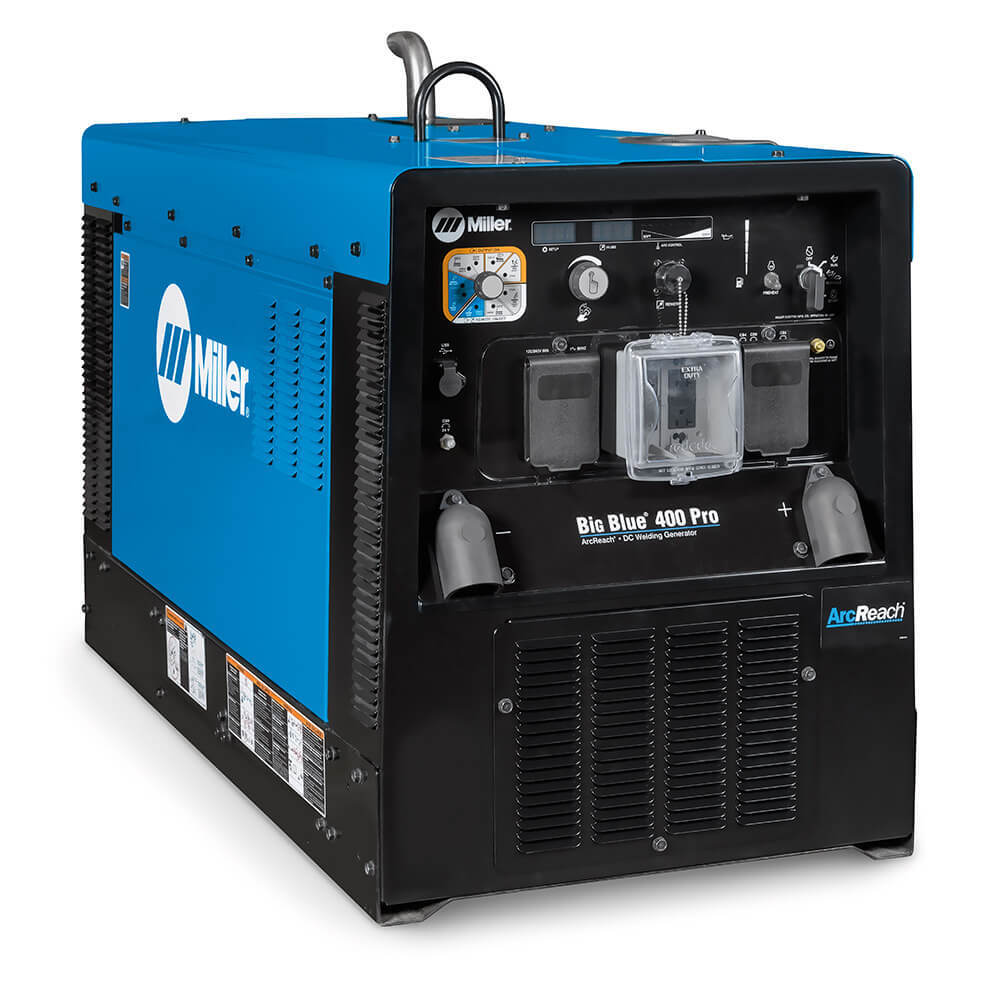
Miller CST 282
The Miller CST 282 has been designed for welding pipe and plate in the construction industry. This compact, 35-pound, goes-anywhere welding machine delivers 280 amps of superior Stick and TIG performance with Auto-Line™ Technology to utilize nearly any source of primary power in the workplace.
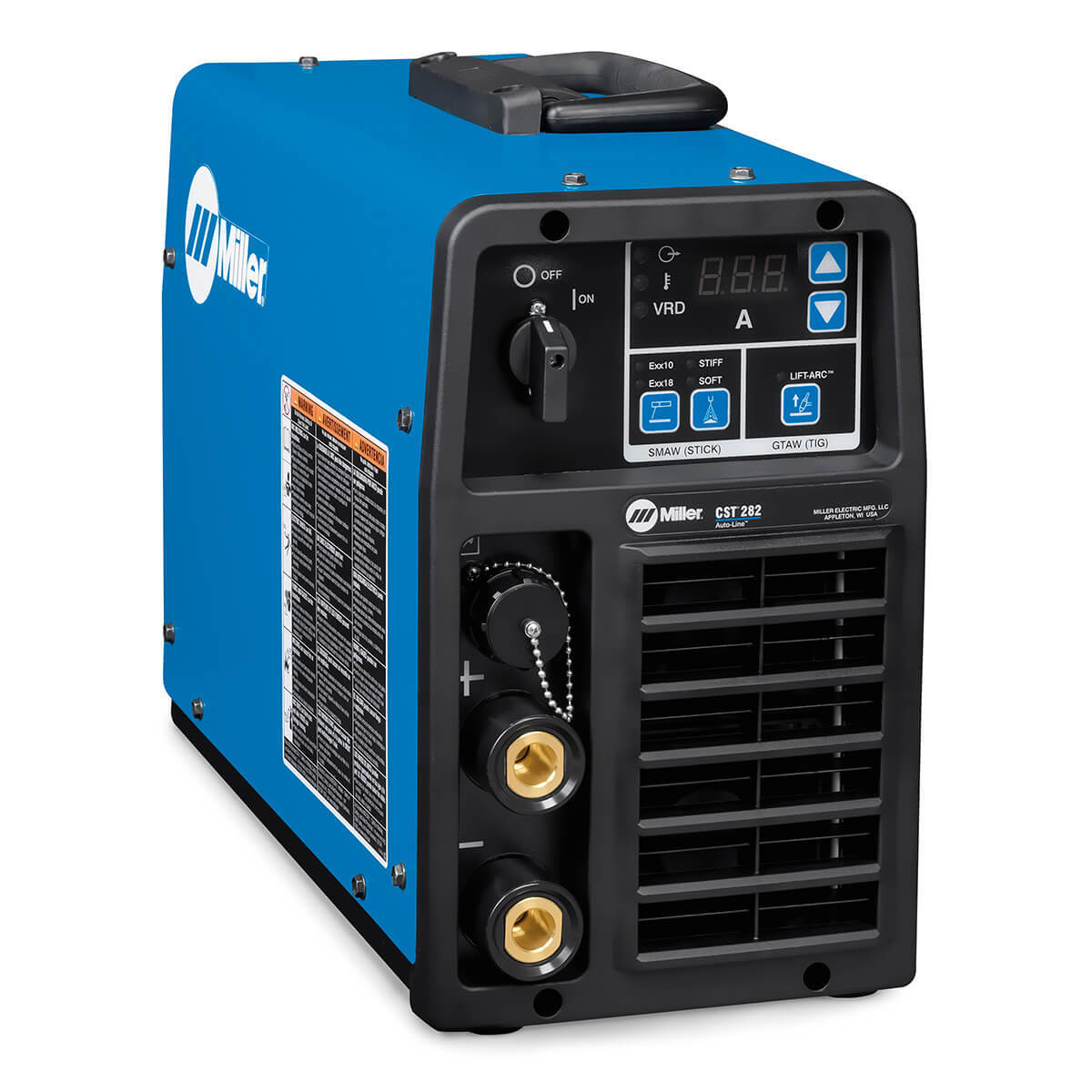
How to choose the ideal hardfacing method?
Choosing the ideal hardfacing method depends on several factors, including the base material, the specific wear or corrosion challenge that needs to be addressed, the environmental conditions in which the equipment will operate, and the desired level of durability and wear resistance.
Here are some general guidelines for choosing the ideal hardfacing method:
Determine the base material: The base material being welded is an important factor in choosing the ideal hardfacing method. Different materials require different welding methods and filler materials.
Identify the wear or corrosion challenge: Before choosing a hardfacing method, it is important to identify the specific wear or corrosion challenge that needs to be addressed. This may include abrasion, impact, erosion, or corrosion.
Consider the operating environment: The environmental conditions in which the equipment will operate are also important. Factors such as temperature, humidity, and exposure to chemicals or corrosive materials can all affect the choice of hardfacing method.
Evaluate the level of wear resistance required: The desired level of wear resistance and durability will also influence the choice of the hardfacing method. Some methods provide higher levels of wear resistance than others, but may also be more expensive or difficult to apply.
Provide training to your operators: Proper training, experience, and adherence to safety guidelines are crucial for using any welding process for hardfacing effectively and safely.
Consult with a welding expert: Consulting with a welding expert can help ensure that the ideal hardfacing method is chosen for the specific application. They can provide guidance on the best welding process, filler material, and surface preparation techniques for the job. We are ready to answer your questions regarding hardfacing.
Get started with hardfacing and save
Probably you already are applying hardfacing in your company, but you are wondering whether the process of choice is the right one. On the other hand, probably you never have used hardfacing, but you have gotten to know about it and realize that could help you to save some money in your operations. Regardless of your specific situation, we can help you to apply hardfacing in your workshop.
We have the equipment, accessories, and consumables you need for hardfacing. Also, our technicians have decades of experience helping companies save by applying hardfacing on their equipment. Let us help you today.

